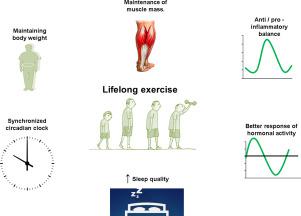Life Sciences ( IF 5.2 ) Pub Date : 2020-09-18 , DOI: 10.1016/j.lfs.2020.118453 Alexandre Abilio de Souza Teixeira 1 , Fábio Santos Lira 2 , José Cesar Rosa-Neto 1

|
Aging is associated with gradual decline in numerous physiological processes, including a reduction in metabolic functions and immunological system. The circadian rhythm plays a vital role in health, and prolonged clock disruptions are associated with chronic diseases. The relationships between clock genes, aging, and immunosenescence are not well understood. Inflammation is an immune response triggered in living organisms in response to the danger associated with pathogens and injury. The term ‘inflammaging’ has been used to describe the chronic low-grade-inflammation that develops with advancing age and predicts susceptibility to age-related pathologies. Equilibrium between pro-and anti-inflammatory cytokines is needed for healthy aging and longevity. Sedentary and poor nutrition style life indices a disruption in circadian rhythm promoting an increase in pro-inflammatory factors or leads for chronic low-grade inflammation. Moreover, signals mediated by pro-inflammatory cytokines, such as tumor necrosis factor-alpha and interleukin-6, might accentuate of the muscle loss during aging. Circadian clock is important to maintain the physiological functions, as maintenance of immune system. A strategy for imposes rhythmicity in the physiological systems may be adopted of exercise training routine. The lifelong regular practice of physical exercise decelerates the processes of aging, providing better quality and prolongation of life. Thus, in this review, we will focus on how aging affects circadian rhythms and its relationship to inflammatory processes (inflammaging), as well as the role of physical exercise as a regulator of the circadian rhythm, promoting aging with rhythmicity.
中文翻译:

有节奏的衰老。可能吗?作为起搏器的体育锻炼。
衰老与许多生理过程的逐渐下降有关,包括代谢功能和免疫系统的下降。昼夜节律在健康中起着至关重要的作用,长时间的时钟干扰与慢性疾病有关。时钟基因,衰老和免疫衰老之间的关系尚不十分清楚。炎症是活生物体针对与病原体和伤害有关的危险而触发的免疫反应。术语“发炎”已用于描述随着年龄增长而发展的慢性低度发炎,并预测了与年龄相关的病理的易感性。为了健康的衰老和长寿,促炎和抗炎细胞因子之间需要保持平衡。久坐和不良的营养风格生活指数是昼夜节律的破坏,促进了促炎因子的增加或导致了慢性低度炎症。而且,由促炎细胞因子介导的信号,例如肿瘤坏死因子-α和白介素-6,可能会加剧衰老过程中的肌肉损失。昼夜节律对于维持生理功能很重要,就像维持免疫系统一样。运动训练程序可以采用在生理系统中施加节律的策略。终生定期进行体育锻炼可减缓衰老过程,提供更好的质量并延长寿命。因此,在这篇综述中,我们将重点关注衰老如何影响昼夜节律及其与炎症过程(发炎)的关系,











































 京公网安备 11010802027423号
京公网安备 11010802027423号